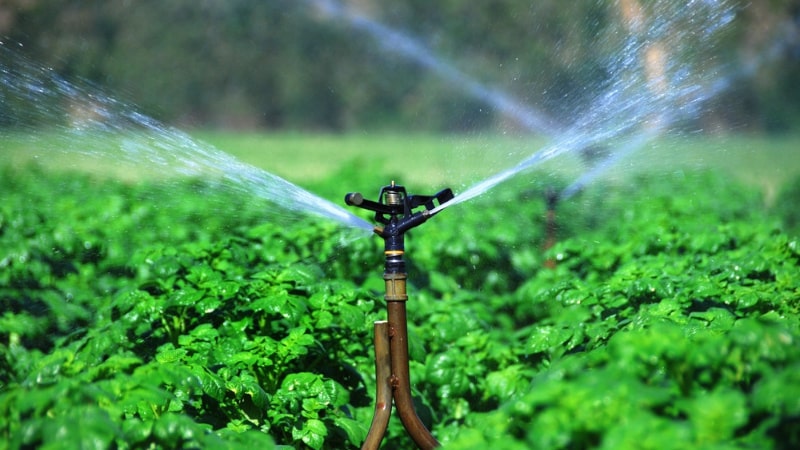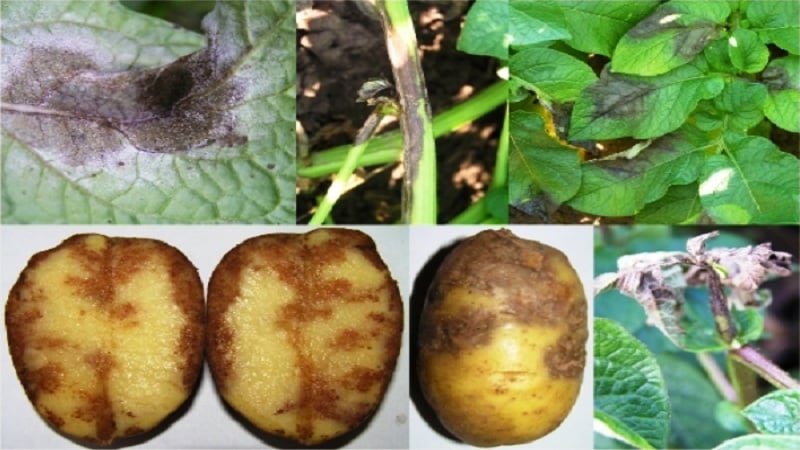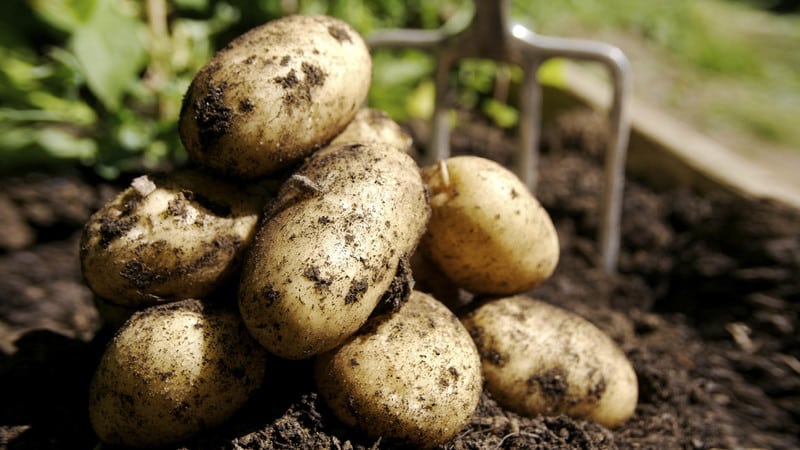The best early potato varieties: “Orchid”, “Lady Claire”, “Assol” and others
Many gardeners want to harvest young potatoes as early as possible, so they give preference to early varieties. Early ripening crops are unpretentious in care, resistant to diseases and, under good conditions, produce 2 harvests per season. Productivity depends not only on the correctly selected variety, but also on the climate, as well as compliance with agricultural practices.
Description of early varieties
Of all 4,000 potato varieties, early-ripening crops are distinguished by ease of care, high yield and good taste.

Orchid
The variety was bred by Belarusian breeders.
The plant is tall with an erect stem covered with medium-sized bright green leaves. The flowers are white, collected in small inflorescences. The ripening period of tubers is 70–90 days.
The yield is high: 8–12 round tubers with small eyes ripen on 1 bush. The average weight of the vegetable is 150 g. The pulp is yellow, contains 16.6–21.5% starch, which gives good digestibility and excellent taste. Potatoes do not darken during heat treatment and slicing. Provided storage conditions are met, it has good shelf life.
The variety is resistant to nematodes, blackleg, wet rot, and is susceptible to scab and late blight of tubers and tops.
Suitable for cultivation in the Middle Volga, Central, Central Black Earth regions.
Assol
This is an early-ripening, high-yielding variety bred by Russian agricultural technicians.Suitable for growing in garden plots.
The bushes are spreading, the stems are erect, the leaves are medium, the flowers are white. The tubers are smooth, elongated oval in shape, covered with a smooth yellow skin. Average weight - 100 g. The pulp is tender and creamy, the taste is good.
The growing season is 50–65 days. Up to 15 tubers are formed on one bush. The plant is resistant to late blight and viral diseases.
The variety is highly resistant to unfavorable climatic conditions, and is therefore suitable for cultivation in all regions of the country. The tubers retain their taste until spring.
Typhoon
Polish early ripening variety. The bushes are large, well developed, with a large number of rich green leaves. The flowers are white, collected in large inflorescences. The tubers are oval-shaped, smooth, covered with a thin yellow skin. The pulp is tender, dense, yellow or cream in color. The eyes are shallow and small in size. One vegetable weighs from 100 g. 6–10 potatoes ripen per bush. The starch content in them is 16–20%.
The variety is drought-resistant and unpretentious to soil composition. Has strong immunity. If you follow the rules of agricultural technology, it gives a rich harvest. The crop is grown not only on personal plots, but also on farms. Vegetables do not lose their taste during storage.
Typhoon is recommended for cultivation throughout Russia, Ukraine and Moldova.
Estrella
An early ripening table variety bred in Germany. In 2011 it was included in the State Register of the Russian Federation.
The bushes are semi-erect or upright, of medium height. The stems are covered with small bright green leaves with wavy edges. The inflorescences are medium-sized purple-pink, the color inside is more saturated. The tubers are oval, average weight - 88–115 g.10–12 vegetables are formed on the bush. Marketable yield is 214–375 c/ha.
The flesh and skin are yellow. The eyes are small and superficial. The starch content is low, 13-14%. Keeping quality - 95%.
Important! The variety is resistant to high temperatures and tolerates dry conditions. With proper care it gives a high yield.
Estrella is immune to potato canker, nematode, banded and wrinkled mosaic. The crop is susceptible to late blight and leaf curl virus. Recommended for cultivation in the North-Western, Central and Volga-Vyatka regions.
Lady Claire
Dutch mid-early variety. The bushes are low with straight shoots that are not prone to lodging. The leaf blade is large with a wrinkled surface and wavy edges, painted dark green. The flowers are white and do not produce berries. The growing season is 65–75 days.
The tubers are smooth, oval in shape, weighing 82–107 g. The peel is dense, thin, and yellow in color. The eyes are small and superficial. The pulp contains up to 16% starch, carotene and vitamin C. Potatoes have a good taste: they contain a lot of dry matter and little water.
Up to 12 vegetables are formed on 1 bush, the yield is 140–167 c/ha. Keeping quality is 94%, vegetables are stored for up to 6 months, while retaining their taste and presentation. Potatoes tolerate transportation well and are not afraid of mechanical damage.
The variety is not affected by diseases and pests (except for late blight) and tolerates lack of moisture and heat. Suitable for growing in greenhouses and open ground, on private plots and large farms. Zoned for the Central, North Caucasus and Central Black Earth regions.
Borovichok
An early ripening variety bred by Russian breeders. The bushes are compact with erect, non-spreading shoots.The leaves are medium-sized with jagged edges and dark green. The flowers are small, cream or white, fall quickly, and produce a small number of berries. The root system is powerful, forming up to 10 fairly large tubers. The period of full ripening is 70–90 days.
The vegetables are dense, regular round in shape, and resemble mushrooms in appearance. The peel is thin but dense. The pulp is tender and contains a large amount of starch and dry matter. The taste is rich, and when cooked, vegetables retain their shape.
Important! The spring planting harvest produces many non-marketable tubers, the number of which is reduced when grown in early summer.
The variety is rarely affected by viruses, potato canker, verticillium, nematode, scab, and late blight. With high humidity or improper watering, gray rot develops.
The tubers are stored until spring, are not damaged by mechanical harvesting, and tolerate transportation well.
The crop is grown on an industrial scale and for personal use in warm and temperate climates. In regions with early spring, Borovichok produces 2 harvests per year.
Velina
Very early productive variety. The bushes are vigorous with straight, compactly spaced shoots. The leaves are bright green, medium in size with well-drawn veins and jagged edges. White flowers are collected in neat inflorescences.
The tubers are medium or large, slightly elongated. The peel is smooth yellow. The eyes are shallow and small. The pulp is tender, creamy in color, has a rich taste, contains a balanced amount of starch, dry matter and moisture, suitable for dietary and baby food.
The ripening period of tubers is 50–60 days.In regions with a warm climate and early spring, the first harvest is harvested within 40 days. Up to 15 potatoes ripen on 1 bush. The average weight of each is 90–100 g. The variety is resistant to nematodes, viral diseases and potato cancer. It is susceptible to attacks by Colorado potato beetles, and when there is excess moisture it is affected by late blight.
Tubers retain their taste and presentation for a long time. The plants are undemanding to soil, resistant to adverse weather and climatic conditions, and therefore suitable for cultivation throughout Russia.
For the middle band
The climate of central Russia is characterized by high humidity and severe snowy winters. Summer temperatures set in at the end of May and persist until the end of September. That is why gardeners here choose varieties that ripen before the autumn cold.
High air humidity and fertile soil allow you to get a good harvest of early potatoes, which have a short growing season and immunity to most diseases: late blight, scab, mosaic virus, black leg, gray rot, rhizoctonia.
Important! For cultivation, crops with good shelf life, resistance to rotting and mechanical damage are selected.
Early potato varieties for central Russia:
- Adretta;
- Rosara;
- Pogarsky;
- Kamensky;
- Bellarosa.
Advantages and disadvantages

The main advantages of early potato varieties:
- high productivity;
- short growing season;
- ease of care;
- disease resistance;
- good taste;
- ability to produce two crops under favorable climatic conditions.
Among the disadvantages, a short shelf life is noted (such tubers will not be stored until spring).
Each variety has its pros and cons:
| Variety | Advantages | Flaws |
| Orchid |
|
With an excess of fertilizers, the tops grow quickly. |
| Assol |
|
No. |
| Typhoon |
|
No. |
| Estrella |
|
Affected by late blight. |
| Lady Claire |
|
No. |
| Borovichok |
|
|
| Velina |
|
|
Features of planting and growing
The rules of agricultural technology for early potatoes do not differ from the methods of growing late varieties, but they have some features.
Preparing for landing

How to grow early potatoes? For planting in open ground, seed material is pre-prepared. Choose tubers that were stored in the basement, without buds or sprouts.Small and diseased specimens are not used.
The potatoes are placed in a warm room, after making a circular cut on each vegetable. Tubers germinate for 20–30 days at a temperature not exceeding +10…+15°C. At higher values, the sprouts will stretch and become brittle.
Attention! To speed up germination, the seed is placed in a container with wet sawdust or peat, pre-treated with a growth stimulant (Epin), a weak solution of potassium permanganate or copper sulfate.
Soil requirements
To get a high yield of early potatoes and reduce ripening time, a sunny area with well-drained and ventilated soil is allocated for the beds.
The culture prefers fertile sandy loam, loamy soil or black soil. Clay soil does not allow air to pass through well and retains moisture, which leads to the development of rot and late blight.
To improve fertility, the site is prepared in the fall. The soil is dug up, weeds are removed and wood ash, humus and organic fertilizers are added. Before planting, the beds are dug up again and mineral fertilizer is applied.
Dates, scheme and rules of planting
Potatoes of early varieties are planted when the soil warms up to +10...+15°C at a depth of 8–10 cm. Do not delay sowing, since germinated tubers are resistant to low temperatures. Typically, planting dates fall at the end of April - beginning of June. It depends on the region and weather conditions.
The beds are located in the direction from south to north. First, peat, wood ash, onion peels or humus are added to the holes. Tubers are laid to a depth of 6 cm at a distance of 30–35 cm from each other, 60–70 cm are left between the beds.
To speed up the emergence of seedlings, the plantings are covered with plastic film or other material. For air circulation, holes are made in a checkerboard pattern at a distance of 15–20 cm. When the threat of frost has passed, the film is removed.
Features of cultivation
Open, well-ventilated, sunny areas are most favorable for the culture. The beds are not placed on the north or east side, in lowlands with clay soil.
Green manures - grains or legumes - are used as precursors.
Potatoes love light. Lack of sun slows down the formation of bushes and reduces the number of tubers. Under normal lighting, the height of the plants is 50–70 cm, the root system is powerful and is located in the fertile layer.
For plantings to bloom, the air temperature should not exceed +20...+23°C, otherwise the flowers will fall off. Tubers are formed at +16…+18°C. Even slight frosts lead to the death of plants.
Nuances of care
Potatoes of early varieties are unpretentious in care. After the emergence of seedlings, the plants are protected from frost, watered, loosened, weeded, hilled and fertilized in a timely manner.
Particular attention is paid to the prevention and control of diseases and pests.
Watering mode

Before budding, the plants are not watered, after which the soil is kept moist. Irrigate the plantings once every 3–5 days, in the morning or evening, using warm water. Before harvesting, the amount of moisture is reduced.
In dry weather, the crop is moistened twice during the season, this is done by drip or under a bush. After watering, the beds are loosened.
Top dressing
During plant development, root and foliar fertilizers are applied. If the tubers are planted in prepared soil, then fertilizers are used after the first shoots appear.During the season, 3-4 feedings are carried out.
Due to the short growing season, early varieties do not have time to stock up on organic matter, so formulations containing dolomite flour, nitrogen, phosphorus and potassium are used.
Mineral agents are applied depending on the condition of the soil and its nitrogen content. If there is a shortage of it, fast-acting nitrogen-containing fertilizers are used.
Important! When growing Borovichok potatoes, mainly phosphate, potassium and organic fertilizers are used. Velina is fed with humus, compost, herbal infusion or diluted bird droppings. Fertilizers are applied 2-3 times: after germination and when tubers form.
Weeding and hilling
Before emergence, loosen and weed the soil carefully so as not to damage the sprouts. In the future, this is done after each watering to provide the roots with oxygen and nutrients and remove weeds.
The crop is earthed up after rain or watering. This creates additional support for the bushes, stimulates the development of the root system and creates the necessary supply of moisture. The procedure is carried out twice per season: when the bushes reach 15–20 cm in height and after 2 weeks, before flowering begins.
Disease and pest control

Most early varieties are resistant to diseases and pests, but some are affected late blight, cancer, scabby, gray rot, rhizoctoniosis, macrosporiosis, brown spotting.
For the prevention of diseases, the drugs “Shirlan” and “Ranman” are used.
When growing Lady Claire, Typhoon, Borovichka, to prevent late blight, plantings are sprayed with a solution of copper sulfate twice during the planting season.
Against Colorado potato beetles, wireworms and chafer larvae use insecticides: “Aktaru”, “Tabu”, “Korado”, “Commander”, “Prestige”. Insects are collected by hand.
Harvest and storage
The growing season for early potatoes ends in early August. In areas with cold climates, the crop is harvested before the first frost.
Harvesting begins after the potatoes are fully ripened, on a warm sunny day. 7–10 days before the start of work, the tops are mowed. They dig with a pitchfork to reduce damage to the tubers. Potatoes are dried in the sun, then moved to the shade. The procedure is repeated for a week.
Important! Vegetables are dried in the open air, protected from direct sunlight, otherwise the vegetables will turn green.
Potatoes are sorted, placed in bags or boxes, and stored in the cellar. To increase their shelf life, they are treated with special means: “Bactofit”, “Fitosporin” or copper sulfate.
In the varieties Assol, Borovichok, Typhoon, Orchidya, Velina, keeping quality reaches 94-95%, so they are kept in the basement at +2...+5°C for 4-5 months.
Difficulties in growing
When growing crops, gardeners face some problems:
- Tops lodging. Occurs due to excess moisture, high content of nitrogen compounds in the soil, lack of light or the use of large planting material. To eliminate the problem, observe crop rotation, watering regimes and the application of mineral fertilizers.
- Lack of flowers. This is caused by a lack or excess of moisture, the use of low-quality seed material, delays in planting, and pest damage. Only healthy tubers are selected for cultivation, fertilizers are applied in a timely manner, the bushes are watered during the dry period, and the plantings are regularly weeded.
- Yellowing and drying of the tops. Often occurs due to viral or fungal diseases, high air humidity. Diseased bushes are removed and the area is treated with copper sulfate. If there is an excess of moisture, the amount of watering is reduced and the soil is loosened more often.
Tips and reviews

Secrets of growing crops from experienced farmers:
- Several early varieties are planted on the plot;
- Before planting, the tubers are treated with biostimulants of growth or a solution of mineral fertilizers: succinic acid, preparations “Epin”, “SILK”.
Many gardeners speak positively about early potato varieties: they note their productivity, unpretentiousness, and excellent taste of vegetables:
Sergey, Astrakhan: «Borovichok did not find any shortcomings in potatoes. The tubers are even, smooth, and of the same size. I grow the crop on loose, sandy loam soil. I plant in mid-April. If the summer is not too rainy, I harvest twice. The tubers are tasty, boil well, and are stored until spring. I use my own seed material for planting in the new season.”
Elena, Novosibirsk: “I have been growing early Orchid potatoes for several years now. We begin digging 1.5 months after planting. Vegetables with yellow flesh, not watery. The yield is high, the taste is excellent. We use the tubers for baking and boiling.”
Evgeniy, Ryazan: “Of the early potato varieties, I prefer Assol. The culture is unpretentious in care and grows on any soil. The tubers grow large, neat, with small eyes. The pulp is tender and crumbly."
Conclusion
Potatoes of early varieties are popular among farmers because they are easy to care for, resistant to many diseases and pests, and quickly produce a rich harvest (twice in the southern regions) of tasty tubers.Plants develop even at low temperatures and drought, and are often undemanding to soil composition.